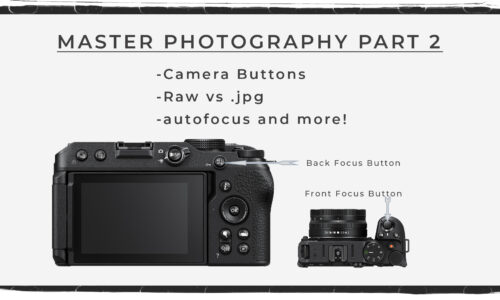Photography 101: Cracking the Code of Camera Settings for Stunning Shots
Photography 101: Cracking the Code of Camera Settings for Stunning Shots
Digital Camera Settings
Getting your hands on a new digital camera is an exhilarating experience, and naturally, your immediate instinct is to start capturing photos. However, it’s crucial to take a moment to adjust some initial camera settings. This step is a bit like a hidden treasure hunt since the location of these settings varies across different camera brands and models. In this video, I’ve taken the initiative to guide you through the essential camera settings that require your attention and explain their functions.
While I understand that slowing down might not be the most exciting aspect, it’s important to recognize that this deliberate approach will ultimately yield significantly enhanced images. The video primarily covers fundamental settings, serving as a foundation. Although there are more settings to explore and customize, starting with these adjustments is a prudent choice.
Camera settings we will tackle in this video.
- Image Quality-Raw vs .jpg
- Autofocus Settings-Manual, Single Servo, and Continuous Servo
- Advanced Autofocus Settings-Face or Subject Detection, Eye Detection, and Animal Eye Detection
- Autofocus Button Settings-Front of Rear/Back Button
- Auto Toning-Active D-Lighting, and Auto Lighting Optimizer
- Drive Settings-Single, Continuous, and Timer
- ISO Settings-Auto or Manual
- Highlight Alert
- White Balance-Auto, Daylight, Shade, Cloudy, Tungsten, Fluorescent, Kelvin, and Custom
- Color Space-sRGB, and Adobe RGB
- Format or Delete
After you chance your basic camera settings this video on how to use Autofocus will head you in the right direction.

“Changing the default camera settings will result in better photography.”
— john whitehead images
I use D65, which stands for 6500 Kelvin. In photography, we measure color temperature in the kelvin scale. If you use D55 you would have a warmer screen and this would change the look of your image on output. Below are some examples of the white balance settings on a camera and their associated Kelvin temperatures. These are just approximations they are not exact. The higher the number in Kelvin the bluer the light, they lower the number the warmer the light.
- Daylight-5500-6500K
- Strobe- 5000-5500K
- Cloudy- 6000K
- Shade-7000K
- Fluorescent-4000K
- Tungsten-3200K
History of the Digital Camera
The history of the digital camera is a fascinating journey that spans several decades, involving the convergence of various technological innovations. Here’s an overview of its evolution:
- Early Concepts (1960s-1970s): The concept of digital imaging dates back to the 1960s. In 1975, an engineer named Steven Sasson, working at Eastman Kodak, created the first prototype of a digital camera. This device used CCD (charge-coupled device) technology to capture and store images digitally, but it was a large and cumbersome machine.
- Development of CCD Technology (1970s-1980s): Throughout the late 1970s and into the 1980s, CCD technology continued to advance, leading to improved image quality and smaller sensors. Various companies and researchers contributed to refining this technology.
- First Commercial Digital Cameras (1980s): In 1981, Sony introduced the Mavica, a camera that used analog video recording onto a floppy disk as a storage medium. In 1986, Canon unveiled the RC-701, which was one of the first all-digital still video cameras. These early models were expensive and mainly used for specialized applications.
- Transition to Consumer Market (1990s): The 1990s saw a gradual shift toward more consumer-friendly digital cameras. Companies like Kodak, Casio, and Nikon released models that were closer in size and functionality to traditional film cameras. The resolution and image quality continued to improve.
- Megapixel Race and Compact Digital Cameras (Late 1990s-2000s): The late 1990s and early 2000s saw the “megapixel race,” where manufacturers competed to offer cameras with higher and higher resolutions. Additionally, compact point-and-shoot digital cameras gained popularity due to their portability and ease of use.
- Integration with Smartphones (2010s): The proliferation of smartphones with built-in cameras revolutionized digital photography. As smartphones advanced, they incorporated increasingly capable camera sensors and software, leading to a decline in the sales of standalone digital cameras.
- Mirrorless and Advanced Digital Cameras (2010s): The 2010s witnessed the rise of mirrorless interchangeable lens cameras, which provided professional-level features and image quality without the bulk of traditional DSLRs. Companies like Sony, Fujifilm, and Olympus played a significant role in popularizing this format.
- High-End and Professional Cameras (2010s-Present): Manufacturers continued to develop high-end digital cameras for professional photographers and enthusiasts. These cameras offer exceptional image quality, advanced features, and extensive customization options.
- Continued Technological Advancements (Present and Beyond): The digital camera landscape continues to evolve with ongoing improvements in sensor technology, image processing, connectivity, and artificial intelligence. Cameras are becoming more integrated with other devices and platforms, further shaping the future of photography.
In summary, the history of the digital camera showcases a progression from experimental prototypes to mainstream consumer products, with constant advancements in technology and changing market trends driving innovation.


